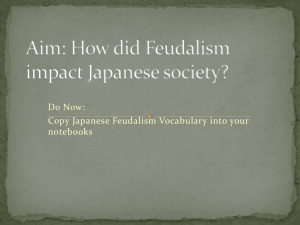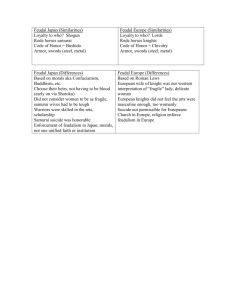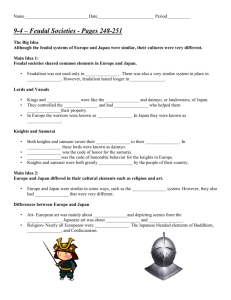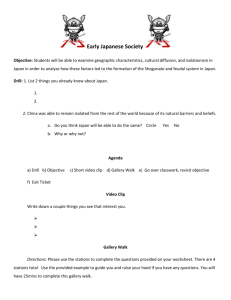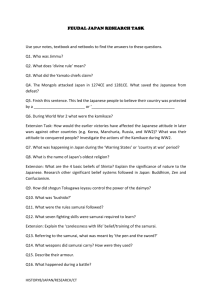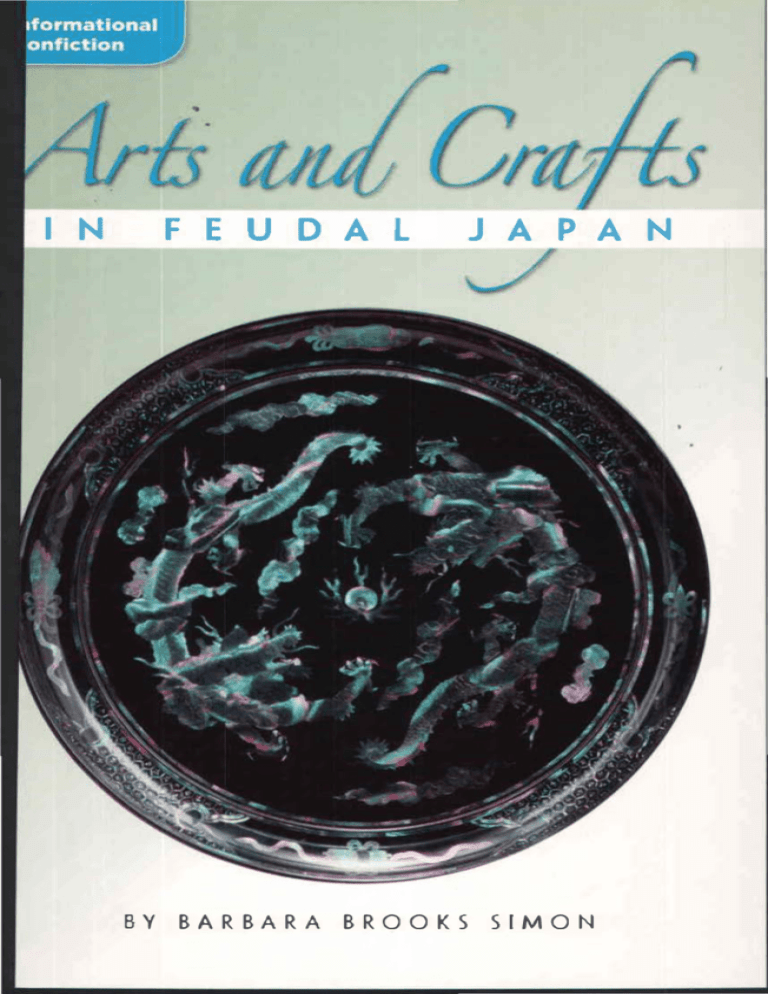
IN
FEUDAL
JAPAN
-::7
BY
BARBARA BROOKS SIMON
..
'
I
I
I
I
-
STR ATEGIES & SKILLS AT A GLANCE
Read to
'
Find Out
I
•
Strategy: Evaluate
•
•
Skill: Evaluate Author's Perspective
What kinds of crafts
•
Vocabulary
I
I
-
I
•
were important
What influenced
I
the style of these
I
arts and crafts?
I
Vocabulary Strategy
•
•
'
-
-
-
-
Homophones
CONTENT-AREA VOCABULARY
t
-
arid, benefit, ceramics, deftly,
derision, eaves, furrows, symmetry
I
I
-
•
�
in feudal Japan?
I
Comprehension
..
photo credits COVER: (b) Seattle Art Museum/
Words that describe Japan and
the arts
(see glossary)
CORBIS. 1: (tc) Granger Collection, New York 4: (br)
Sakamoto Photo Research/CORBIS. 5: (t) Royalty-Free/
CORBIS; (tr) Fujifotos/The Image Works 6: (tl) Time
Life Pictures/Getty Images; (cr) Seattle Art Museum/
CORBIS. 7: (br) Sakamoto Photo Reseorch/CORBIS. 8:
(t) Burstein Collection/CORBIS. 9: (c) Royalty-Free/
NATIONAL CONTENT STANDARDS
Social Studies
CORBIS; (be) Werner Forman/Art Resource, NY. 10:
(cr) Bettmonn/CORBIS. 12: (tc) Royalty-Free/CORBIS;
(tr) Michael Freeman/CORBIS 13: (tr) Hulton-Deutsch
•
Culture
Collectian/CORBIS; (c) Royolty-Free/CORBIS 14: (b)
•
Time, Continuity, and Change
Aroldo de Luca/CORBIS. IS: (all) Michael Moslon
Historic Photogrophs/CORBIS 16: (b) The British
Museum/Tophom-HIP/The Image Works. 17: (c)
Royalty-Free/CORBIS; (cr) Victoria & Albert Museum,
London/Art Resource, NY 18: (b) Cloy Perry/CORBIS
19: (t) Michael S Yamoshito/CORBIS. 20: (c) Royolty­
Free/CORBIS 21: (bkgd) Royolty-Free/CORBIS.
Word count: 1,728**
A
The McGrow·Hill Companies
B Macmillan
B McGraw-Hill
Published by Macmillan/McGraw-Hill, of McGraw-Hill Education, a division of
The McGraw-Hill Companies, Inc., Two Penn Plaza, New York, New York 10121.
Copyright© by Macmillan/McGraw-Hill. All rights reserved. No port of this publication
may be repro duced or distributed in any form or by any means, or stored in a database or
retrieval system, without the prior written consent of The McGraw-Hill Companies, Inc.,
including, but not limited to, network storage or transmission, or broadcast for distance
learning.
Printed in the United States of America
I 2 3 4 5 6 7 8 9 026 10 09 08 07 06 OS
**The total word count is based on words in the running text and headings only.
Numerals and words in captions, labels, diagrams, charts, and sidebars ore not included.
Arts
IN
JAP A N
FEU DAL
BY BARBARA BROOKS SIMON
Table of Contents
Introduction
.
.
.
.
.
.
.
.
.
.
.
.
.
.
.
.
.
.
.
.
.
.
.
.
.
.
2
.
.
.
.
.
.
.
.
.
.
.
.
.
.
.
.
.
.
.
.
.
.
.
.
.
.
4
.
.
.
.
.
.
.
.
.
.
.
.
.
.
.
.
.
.
.
.
.
.
.
.
.
.
.
.
.
.
.
.
.
.
.
.
.
.
.
.
.
.
.
.
.
.
.
.
.
.
16
National Treasures
.
.
.
.
.
.
.
.
.
.
.
.
.
.
.
.
.
.
.
.
18
.
.
.
.
.
.
.
Chapter 1
Potters and Painters
Chapter 2
The Samurai Sword
10
Chapter 3
Zen and the Arts
.
.
Chapter 4
Living
Conclusion
.
.
.
.
.
.
.
.
.
.
.
.
.
.
.
.
.
.
.
.
.
.
.
.
.
.
.
.
.
.
.
.
.
.
21
Glossary
.
.
.
.
.
.
.
.
.
.
.
.
.
.
.
.
.
.
.
.
.
.
.
.
.
.
.
.
.
.
.
.
.
.
.
.
22
Index
.
.
.
.
.
.
.
.
.
.
.
.
.
.
.
.
.
.
.
.
.
.
.
.
.
.
.
.
.
.
.
.
.
.
.
.
23
.
.
.
.
.
.
.
.
.
.
.
.
.
.
.
.
.
.
.
.
.
.
.
24
.
.
.
Comprehension Check
INTRODUCTION
If you were to travel back in time to Japan in
the Middle Ages, you might witness fierce battles
between warriors and cruel and bloody wars. But
you might also see an artist creating a beautiful
piece of pottery or a craftsman making an
elaborate sword.
Japan was organized by a system called
feudalism. At the top of society was the emperor.
He was important but didn't control the country.
The real ruler was a military leader called a
shogun.
Below the shogun were
powerful landowning lords.
Their extended families were
called clans. To protect their
land, lords needed an army
of highly trained warriors.
These warriors were
called samurai.
There were also craftspeople
who made sword s for the samurai
that were works of art. And
artists created paintings and
0 Samurai were
pottery. Some of the feudal arts
brave and loyal
fighters. Showing
and crafts traditions can still
fear brought
be seen in Japanese art today.
them shame
and derision.
U The samurai were excellent swordsmen.
cGm-r
POTTERS AND PAINTERS
M
any skilled craftspeople in feudal Japan lived
and worked on their lord's estate. They were
potters, carpenters, weavers, and smiths. In later
years, craftspeople were no long er tied to an
estate. They often worked on their own. Grad ually,
craftspeople won respect. In time, Japanese
ceramics, or pottery, became world famous.
So d id other Japanese art forms.
The Japanese have a long trad ition of
loving nature and natural o bjects. An
interesting rock or a twisted pine tree
can inspire a poem or painting.
In feudal times, the Japanese
admired natural qualities in their
pottery. Instead of a smooth,
perfect finish, they wanted to
see the mark of an individual
worker. For example, the potter's
fingers might leave ridges or
furrows on the surface of a vase.
That made it more interesting.
4
.
ART· _IN
.
THii
,(.
'
·
1:-iOM�
.. �.
.
Paintings and other works
of art held an important
place in traditional Japanese
homes. Even today, a small
corner is often set aside
to hold a few special art
treasures. This spot is called
the tokonoma. Usually there
is a hanging painting, or
scroll. A shelf below might
display a treasured piece
of pottery and perhaps an
arrangement of flowers.
Potters often made their works look irregular
on purpose. They shaped a pot by hand, instead
of spinning it on a potter's wheel. They d idn't
try for perfect symmetry, or both sides matching
perfectly. Instead, they made the sides of a pot
slightly lopsided. Some tried to make pottery that
looked as natural as a stone.
<: This vase from the feudal era
has the imperfect quality that
the Japanese admired.
5
H A modern-day potter
uses ancient techniques.
The coat of finish put onto clay pottery is called
the glaze. Japanese potters used glazes to create
a natural look. For instance, the colored glaze on
a vase might be streaky. The glassy surface might
have tiny bubbles. Some finishes were deliberately
made to look cracked. One style with deep cracks
was called "dragon skin." As a finishing touch, a
potter deftly painted simple decorative lines.
6
Potters in different reg ions of feudal Japan
developed their own styles. In some places,
potters specialized in making unglazed pots.
Others used d istinctive glazes-dark brown or
green or white.
From a pot's style you could
tell where it was made.
In early feudal Japan, most pottery was
made for rituals. It was used in ceremonies
in Buddhist or Shinto temples
or in tea ceremonies. At home,
people used wooden d ishes.
Sometimes the wood was
finished with a hard, shiny
surface. This was made
by applying many
coats of lacquer.
Later
on, potters made tea
bowls, plates, and
saucers for people to
use at home.
This stoneware jar was
:>
made between 1333-1392.
7
0 This scroll painting shows a rebellion against the shogun
in the city of Kyoto in the 1100s.
Another favorite art form was scroll painting.
A scroll is a strip of paper or fabric that can be
rolled up. Scroll painters used rich, bold colors. They
told an exciting story in pictures and sometimes
with words. Scrolls pictured historical events, such as
wars between families. Some showed scenes from
popular stories. Others retold legends. The viewer
unrolled the scroll as he or she "read" each scene.
8
Later another painting style developed. These
paintings showed scenes from everyday life.
In
medieval Europe, artists painted mostly relig ious
subjects.
But Japanese artists showed ordinary
people at work and play. They painted travelers
on the country's highways. Artists pictured people
in parades and processions. They showed dancers
and actors in the theater. They showed farmers
and fishermen at work. These lively scenes were
very popular. They decorated fans and folding
silk screens.
.
CA
.
·�lGRAPH '
'
,.
I
..
One unusual feature of Japanese paintings is the
use of calligraphy (kuh-LIG-ruh-fee), or decorative
handwriting. The characters used to write Japanese
are a mix of Chinese characters and forms called
kana.
Most of these symbols are made of graceful,
swooping lines. Japanese artists often use them as
part of the design in paintings. They also appear as
decorations on ceramics and lacquerware.
..
...
...
9
�Gm-2
THE SAMURAI SWORD
T
he samurai were an important class in
feudal Japan. They were known for
being powerful fighters and swordsmen.
Their swords were very important to
them. Japanese swordsmiths made the
world's finest swords. They were famous
all over East Asia.
The best Japanese swordsmiths
worked between A.o. 900 and 1450. These
craftsmen were honored and respected.
Swordsmiths were so proud of their craft
that they signed their swords.
A samurai carried two
curved swords. One was
short, the other long. Samurai fought
on horseback and on foot. In battle,
they often used a bow and arrow. But
their swords were special. They always
carried them.
10
A shogun often chose favorite swordsmiths.
So d id local feudal lords. These craftsmen often
became successful and famous. Lords asked their
swordsmiths to make special "gift swords." These
were a way of thanking a warrior for his service.
Gift giving is an important part of Japanese culture.
A beautiful sword was one of the finest g ifts
anyone could g ive or receive.
A sword was not just a weapon. It was a work
of art. Swords were both elegant and beautiful.
Every piece of the sword was carefully crafted.
The handle was decorated with braided ornaments.
The scabbard, or holder, was often made of
beautifully lacquered wood.
Even the guard that
protected the warrior's hand was finely designed.
The most important part of the sword was
the blade. A g ood sword had to be tough and
rigid.
It had to be razor sharp. The blade also
had to be almost unbreakable so that it would
not snap easily. That could happen if a sword
was too brittle.
e This modern man is dressed as a feudal samurai. He
carries two curved swords, one short and one long.
11
Each samurai sword needed a sword guard, or
tsuba,
to keep the warrior's hand from slipping onto the
sharp blade in battle. Sword guards became a
special art form. They were usually an oval
or a rectangle with rounded corners. A
cutout in the center slipped over the
sword blade. Most sword guards were
made of blackened iron. Different
types of designs, such as dragons,
decorated the surface.
The swordsmith labored over the blade. He
fashioned a k ind of "sandwich" of two different
kinds of metals. The outside layer of a finished
sword was tough, hard steel. The inner core was
iron. Steel can be brittle. But iron, though strong,
is softer and more flexible.
Making this metal "sandwich" took great skill.
The swordsmith heated the different layers of metal
until they were red hot. He folded them over many
times. Then he hammered the metal into the shape
of a sword. He heated it again and then plunged
it quickly into cold water to harden the blade.
During this time, he had to make sure the blade
didn't become either too soft or too hard.
12
This method made the
sword more beautiful. It
created different patterns on
the sword blad e. One pattern
looked like wavy white clouds.
People saw it as blossoms on
faraway trees. Another pattern
looked like a band of bright
crystals in the metal surface.
0 These modern-day
actors are demonstrating
the art of making swords.
At the end the swordsmith
might sign the blade.
He'd put
his signature or another design under the handle.
Then he passed it on to the polishers.
Muramasa and Masume were two famous swordsmiths.
They were rivals. Which one could make the sharper
sword? They held a contest to decide. The two men
went to a fast-running stream. Dead leaves were
rushing downstream in the current. Muramasa held
his sword in the stream. The blade was so sharp
that every leaf that touched it was cut in two. Then
Masume held his sword in the water. Something
strange happened. The leaves avoided the sword and
floated past on either side. Everyone agreed that
Masume's sword was superior. It must have some
kind of special power that pushed the leaves away!
13
In a way, polishing the sword was almost as
important as forging, or shaping it. It could take
as long as two weeks. Skilled craftspeople used
10 or 20 k inds of stone. They patiently rubbed
the blade to even out the surface and be sure
the edg e was very sharp.
While the swordsmith and others focused on
the blade, other craftsmen were at work. Some
made the scabbard, or holder. Some made the
hand g uard. Finally, the treasured sword was
finished . A samurai in full armor, with his sword,
was an impressive sight. A samurai warrior
treasured his sword . He passed it on to his
children. When a samurai child was born, servants
brought a sword into the room.
A samurai wanted to look
both fierce and elegant. His
armor and his sword were
magnificently decorated.
These modern-day models
pose as samurai.
14
:>
C�ter�?
ZEN A D THE ARTS
I
n the 1200s, a new form of Buddhism, called
Zen, came to Japan. Zen Buddhism was soon
popular among the samurai. Zen came to have a
lot of influence on the arts.
Zen emphasized stillness and discipline.
It
demanded great concentration. Those ideas
affected handwriting, architecture, and even
tea drinking! Zen paintings were simple. Often
they had only a few bold brush strokes in black
ink on a white background suggesting a tree
branch, a cliff, or a rock.
0 This seventeenth century ha ngi ng scroll shows the art
of calligraphy.
Zen ideas affected garden styles, too. One
style of Zen garden uses mainly rocks and
gravel. That may sound bare and arid. In fact,
these gardens are peaceful and beautiful. Large
rocks represent mountains. The gravel is raked
into patterns that imitate the currents of a river.
Zen monks originally created these gardens for
temples. Over time they became part of
Japanese tradition.
The tea ceremony, a Japanese tradition, was started by
a Buddhist monk. The tea ceremony takes place in the
peaceful surroundings of a tea house, perhaps on a
quiet autumn eve. Tea drinkers pass through a garden,
walking on stepping stones to reach the tea house. It is
a simple wooden building with wide eaves.
The tea master carefully chooses every
item for the ceremony. Fine ceramic
bowls, tea caddies, and other
containers are used for the tea
ceremony. The tea master whips
powdered tea to froth in a
bowl. It is passed from person
to person. Tea drinkers follow
each step carefully, forgetting
the everyday world outside.
17
�-4
_
_
__
LIVING NATIONAL TREASURES
J
apanese artistic traditions rest on three
main ideas. They show a love of nature.
They find beauty in simple, natural things. They
also demand high standards of craftsmanship.
Craftspeople respect their tools and the material
they work with. They prize natural materials, such
as wood, stone, and bamboo.
0 This Ja panese garden is peaceful and beautiful.
<: This ceramics artist has
been named a "Living
National Treasure."
He is the seventeenth
generation in his family
to work with ceramics.
These traditions are very old. Many began in
the Middle Ages. Artists and craftspeople have
always held a special place in Japanese culture.
Artists in other places have also received the
benefit of Japanese artistic traditions.
But in the years after World War I I, many
people in Japan were afraid that the old art forms
and techniques were disappearing. Modern factory­
made goods were driving them out. In 1955, Japan
began to recognize its artists and artisans with a
special title. They hoped it would help preserve
these crafts. These artists and artisans would make
things in the traditional way. They named these
men and women "Living National Treasures." In
Japanese, that is ningen kokuho.
19
About 100 men and women now hold the
proud title of " Living National Treasure." Many
of the " Living Treasures" are potters.
Some are
swordsmiths, while others weave baskets of bamboo
or specialize in dyeing silk fabric to make kimonos.
Some are actors and musicians who carry on
traditional Japanese art forms. Still others are poets.
These master craftspeople have learned
traditional methods.
Most of them have worked
on their craft for many decades. But some also
experiment with new ways of working. That helps
keep the craft tradition alive and growing.
JAP.AtitesE .
. .
PO·
TRY
Poetry was another popular art form in the Middle
Ages. Noble men and women at the emperor's court,
as well as samurai, wrote poems. Poems were often
short and had a definite pattern.
A haiku (HIGH-kew) is one popular form. A haiku
has three lines. The first and third lines have five
syllables. The middle line has seven syllables. A haiku
often gives a quick word picture of an event in
nature. The haiku below is by a famous poet,
Matsuo Basho.
An old silent pond . . .
A frog jumps into the pond,
splash! Silence again.
20
CONCLUSIO
J apanese artistic traditions are very old. In
feudal Japan-about 900 to 1600-certain arts
and crafts were very important. The samurai, the
warriors of feudal Japan, had a strong influence.
The Japanese were the master pottery makers of
this period. They were also the best swordsmiths
in the world. Zen Buddhism added ideas of
simplicity and discipline to older artistic traditions.
Many things have changed since feudal times.
But the Japanese still try to preserve and protect
ancient forms of craftsmanship and honor the
people who have mastered the skills to pass on
these traditions.
Glossary
calligraphy (kuh-L IG-ruh-fee) the art of beautiful or decorative
handwriting (page 9)
ceramics (suh-RAM-iks) the art of making bowls, dishes, vases,
and other things out of baked clay (page 4)
clan (KLAN) an extended family in ancient Japan (page 3)
culture (KUL-chur) the arts, beliefs, and customs that make up a
way of life for a group of people at a certain time (page 77)
feudalism (F YEW-duh-/iz-uhm) the social and political
organization in medieval Japan and Europe, in which a lord
provided land and protection for people under his rule. In
return they gave services and a share of their crops. (page 2)
forge (FAWRJ) to shape metal into a hardened mass (page 74)
glaze (GLAYZ) the final shiny coating applied to ceramics (page 6)
haiku (HIGH-kyew) a form of Japanese poetry. A haiku has
three lines with five, seven, and five syllables. Many haiku are
about nature. (page 20)
lacquer (LAK-ur) a hard coating of varnish (page 7)
samurai (SAM-oo-righ) the warrior class in medieval Japan (page 3)
scroll (SKR OHL ) a strip of paper or fabric that can be rolled
up (page 8)
shogun (SHOH-guhn) the military commander who headed the
government in feudal Japan (page 2)
tradition (truh-0/SH-uhn) a custom or belief that is passed on
from parents to their children (page 77)
22
Index
Buddhism, 7, 76-77
calligraphy, 9, 76
ceramics, 4, 9, 79
feudalism, 2-3,
7, 27
glaze, 6-7
haiku, 20
lacquered wood, 7, 9, 77
"Living National Treasures," 78-20
Masume (swordsmith), 73
Muramasa (swordsmith), 73
nature, love of, 4, 78-79
painting, 3-5, 8-9, 76
poetry, 3, 20
potters, pottery, 3-7, 20-27
samurai, 3, 70-72, 74-75, 20-27
scroll painting, 8
shogun, 2-3, 8, 77
steel, 72
sword making, 3, 70-74
sword guard (tsuba), 77, 72, 74
swordsmiths, 3, 70-74, 20-27
tea ceremony, 7, 77
tokonoma, 5
Zen Buddhism, 76, 27
Zen gardens, 77
23
Comprehension Check
Summarize
Use an Author's Perspective Chart
to summarize the main idea of each
chapter of Arts and Crafts in Feudal
Japan.
Include the author's perspective
for each chapter.
Think and Compare
1 . Turn to pages 16-17. What is the author's perspective
on the influence of Zen Buddhism on Japanese art?
(Evaluate Author,s Perspective)
2. Which of the craftspeople described in the book
would you like to watch while they work? Why?
(Evaluate)
3. The people of Japan have made a special effort to
preserve old forms of craftsmanship. Do you think
this is a worthwhile idea? Why or why not?
(Analyze/Evaluate)
24
WRITE ABOUT ART
Look back at the paintings, ceramics, and
swords pictured in this book. Choose one object
and write a paragraph describing what you think
it shows about feudal Japan.
INTERVIEW AN ARTIST
Arrange an interview with a local potter or painter.
Before the interview, draw up a list of questions to
ask him or her. You might ask why he or she chose
this work, what training it took to learn it, and how
h e or she developed a certain style.
From teacups to swords, the crafts made
in feudal Japan became famous throughout
Asia. What were the secrets of these
craftspeople? What ideas inspired them?
6.4 WeekS
The McGrow·Hill Companies
ISBN O·Di!<L�3���-3
Macmillan
McGraw-Hill
·'J.'

